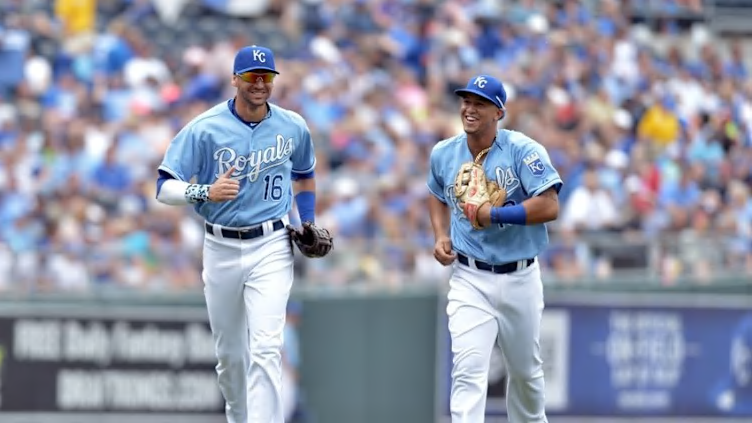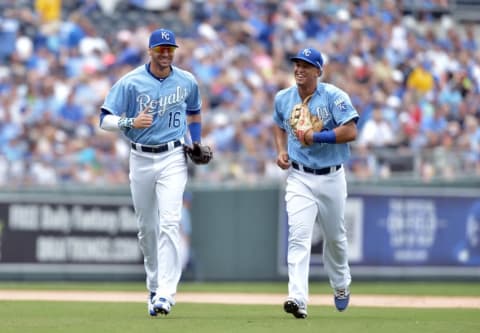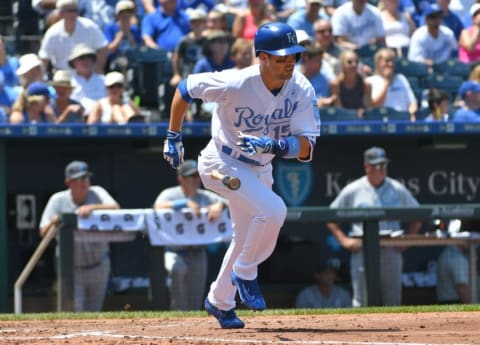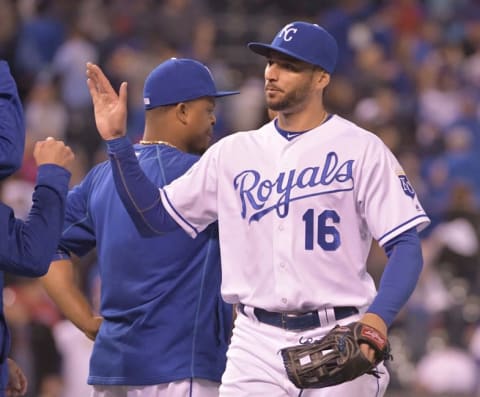KC Royals: Are Merrifield, Eibner, And Orlando For Real?


The KC Royals have gained a much-needed offense boost from young position players Whit Merrifield, Brett Eibner, and Paulo Orlando that have helped them overcome injuries to Alex Gordon and Mike Moustakas. Are the young guys for real, or just riding a hot streak?
That’s the biggest question that Kansas City Royals general manager Dayton Moore needs to answer over the next six weeks before the August 1 trading deadline. If the young players can be counted on for solid production, then Moore can focus his efforts on landing another starting pitcher. If not, Moore will need to seek help for his lineup.
Utility man Whit Merrifield, outfielder Brett Eibner, and outfielder Paulo Orlando all have OPS numbers over .800. Rookie Cheslor Cuthbert is also starting regularly, but his .268/.303/.368 triple slash is more in line with what you’d expect from a first-year player getting his first taste of regular action.
The solid production from these four players has helped the KC Royals remain afloat in the AL Central despite losing two 2015 All-Stars in Alex Gordon and Mike Moustakas over the last month, and Omar Infante and Kendrys Morales ineffectiveness in the season’s first 10 weeks. At 38-31, and only 0.5 behind AL Central leader Cleveland Indians, the Kansas City Royals are in the thick of the race.
At this point, the young reserves have given the Kansas City Royals everything they could have expected before the season began. They have stepped in on a short term basis to handle an injury crisis. But, can they give more? Can they produce over the long-term?
Answering this question correctly could be the key to the KC Royals hopes of repeating in 2016. Let’s look at each of the players individually:
Next: Whit Merrifield

1) Whit Merrifield
Merrifield is hitting an outstanding .333/.350/.483 in his first 28 games with the KC Royals. If he could maintain such production playing mostly at second base, he’d become one of the most valuable second sackers in the game.
However, there’s little chance he will keep up the pace.
More from KC Royals News
- KC Royals Rumors: Is a monster move in the cards?
- KC Royals Free Agent Hunt: 3 Tampa Bay pitchers
- Grading the 2022 KC Royals: The $25 million man
- KC Royals Winter Meetings Tracker: Expectations met
- KC Royals Winter Meetings Tracker: Day 3 update
The first number that jumps out at me from his stats is the .400 BABIP (Batting Average Balls In Play). That’s unsustainable. A typical major-league hitter sits around .300, but a speedy player like Merrifield can expect to sustain a slightly higher BABIP due to his ability to beat out infield hits.
Of course, top hitters sustain a BABIP well above average. For example, Ichiro Suzuki has a career .340 BABIP. The Kansas City Royals’ own Lorenzo Cain enjoys a career .346 BABIP. So where can we expect Merrifield to sit on this scale? Is he a guy that can sustain a high BABIP?
The next number to notice about Merrifield’s early performance is his exceptionally high 36.1% hard hit ball percentage. Merrifield also has a 49.5% medium hit rate with a mere 14.4% soft hit rate. This data suggests that Merrfield’s high BABIP for the KC Royals isn’t exactly luck. He’s hitting the ball hard.
Merrifield’s Exceptional 36.1% hard hit ball percentage suggests his high BABIP isn’t all luck
Of course, a player on a hot streak could also be seeing the ball unusually well over the short term—leading him to hit the ball with more authority than you can expect on a regular basis. But, it does make me feel better that Merrfield’s high BABIP is about him striking the ball well rather than getting fortunate with ball placement.
Merrifield told MLB.com’s Jeffrey Flanagan that he’s hitting the ball harder due to some adjustments to his game that he began last October. First, Merrifield wanted to get stronger and embarked on an elaborate strength training program. Second, Merrifield started to release his top hand from the bat during his follow through.
At this point, it’s hard to argue with the results. Merrifield is hitting the ball with more authority against major-league competition than he’s ever shown against weaker competition in the minors.
That change has to give Kansas City Royals fans hope that a guy that every team in baseball could have claimed in the Rule 5 draft last winter can provide top-shelf performance over a full-season.
In the end, I think Merrifield’s triple slash is likely to come down; but his range, versatility, and speed on the basepaths are all valuable skills. I believe Merrifield will prove to be an above-average middle infielder for the KC Royals. With his ability to play every position except catcher, that will make him a valuable player for years to come.
Next: Brett Eibner

2) Brett Eibner
Eibner has played a total of eight games for the KC Royals, which is almost statistically insignificant. Conventional wisdom suggests there’s little we can tell about Brett Eibner as a major league player given such limited exposure.
More from Kings of Kauffman
- KC Royals Rumors: Is a monster move in the cards?
- KC Royals Free Agent Hunt: 3 Tampa Bay pitchers
- Grading the 2022 KC Royals: The $25 million man
- KC Royals Winter Meetings Tracker: Expectations met
- KC Royals Winter Meetings Tracker: Day 3 update
Of course, his eight games have been pretty damn good. Overall, Eibner is slashing .310/.355/.552 with 4 doubles, 1 home run, and 6 RBIs. He put his jersey in the Kansas City Royals Hall-Of-Fame in his second game by stroking a game-winning RBI single to finish off a franchise record seven-run ninth inning comeback to pull off an emotional 8-7 win.
Eibner has also flashed good range in the outfield, speed on the base paths, and pop at the plate in his short stay with the KC Royals. We haven’t really seen him show off his outfield arm, but many teams wanted him to become a pitcher rather than a position player before the 2010 draft. I suspect he’s not a good guy to run on.
Aside from his athleticism, his BABIP is simply unsustainable at an outrageous .421. Eibner is hitting the ball quite hard, with a 33.3% hard hit rate, 47.1% medium rate, and 19.0% soft hit rate. Steamer projects him to slash a much more humble .243/.310/.393, while ZiPs sees him hitting .221/.279/.369.
If these projections based on Eibner’s minor league numbers are close to reality, he’s really a backup outfielder. Notice that I didn’t mention either projection system with respect to Whit Merrifield. I didn’t consider them reliable given the clear effect from his recent adjustments.
Of course, Dayton Moore has six more weeks to observe Eibner, and he’ll have a lot more data to make a decision. But, as of now, the Kansas City Royals can’t really expect him to hold down a starting spot in the lineup.
Next: Paulo Orlando

3) Paulo Orlando
Paulo Orlando is hitting much better as a second year player for the KC Royals, slashing an outstanding .353/.380/.460 in 159 at bats in 2016. Though defensive metrics rated Orlando a plus defender, this season he’s already -5.0 runs below average. Overall, however, his strong bat has made him appear to be a viable starting outfielder.
More from KC Royals News
- KC Royals Rumors: Is a monster move in the cards?
- KC Royals Free Agent Hunt: 3 Tampa Bay pitchers
- Grading the 2022 KC Royals: The $25 million man
- KC Royals Winter Meetings Tracker: Expectations met
- KC Royals Winter Meetings Tracker: Day 3 update
However, Orlando BABIP is an outrageous .452 which is in no way sustainable. His hard hit rate is nothing special at 23.9%, which is around seven percent lower than his 31.4% hard hit rate in 2015. Given Orlando’s much better results in 2016 despite making softer contact suggests Orlando isn’t going to continue his current success.
The other main difference I see in Orlando’s Fangraphs.com data is that he’s swinging more aggressively. His swing rate is up 4% from 53.0% in 2015 to 57.5% in 2016. He’s swinging more often at both pitches in and out of the strike zone. And his on base percentage is a much better .380 over his substandard .269 in 2015.
However, that OBP improvement doesn’t look long-term given his outrageously high BABIP. His walk rate remains an exceptionally low 2.5%, which is only slightly better than his 2.0% walk rate in 2015.
Give this data, I’m pretty confident that Orlando’s recent performance is a mirage. Enjoy it while it lasts KC Royals fans, but I doubt he’ll keep it up for much longer.
Next: Jon Jay IS A Possible Trade Target For Royals
If my analysis is correct, Dayton Moore would be wise to explore outfield options on the trade market. While I believe Whit Merrifield will continue to be a viable starter at second base, add an outfield bat would be a smart move for the Kansas City Royals.